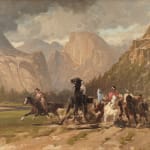James D. Smillie 1833-1909
Framed dimensions: 17 1/2 x 27 1/2 in
While at Yosemite, Smillie witnessed a striking horse race that would become one of his signature subjects for the next two decades. He completed this sketch of the subject either during the 1871 trip or immediately thereafter. He describes the experience in detail in Picturesque America:
"One Sunday morning I strolled to the upper end of the valley; a quiet like that of languor filled the air; the roar of the Yosemite Fall had died out, and now but a slender stream down the face of the cliff marked its place. In the hush I walked under the pine-trees, whose pendulous branches and long, tremulous needles vibrated into an Aeolian melody upon the slightest provocation; a scarcely perceptible breeze brought whispers, to be caught only by the attentive ear; that swelled through faultless crescendos into volumes of harmony, rich and deep, yet ever sounding strangely far away. From the shadows and music out to the sunlighted meadow was but a step. At the other extremity of the open space, four or five hundred yards away, was a group of men. Drawing nearer, it was plainly to be seen that they were intent upon the preliminaries of a horse-race. There were Indians, Chinamen, Mexicans, negroes, and very dark-colored specimens of white men. There was a confusion of tongues, through which came the clear ring of clinking gold and silver coin, for all were betting—many of them their last dollar. Several horses were getting ready for the race; the favorites were a sorrel and a roan, or ‘blue horse;’ all were very ordinary animals, and without the slightest training. There were no saddles; the riders, stripped of all superfluous clothing, bareheaded and barefooted, rode with only a sheepskin or a bit of blanket under them; over the drawn-up knees around the horse’s body a surcingle was tightly drawn, binding horse and rider into one. Judges, starters, and umpires, were selected and positions taken. The word was given; the horses plunged, started, ‘bucked;’ again they started; again the sorrel bucked. An unlimited amount of profanity expressed the impatience of the crowd. The ‘blue horse’ was now largely the favorite.
At last they came—a cloud of dust, rattling hoofs, and frantic riders playing their whips right and left over the struggling brutes under them; on they came; the squatting crowd sprang to their feet, and up went one simultaneous yell; on they came, the crowd capering, screaming, and ‘hollerin’, like so many madmen—all alike infected, the stoical Indian as well as the mercurial Mexican. The ‘blue horse’ led, and, in a cloud of dust, all dashed by. It was a whirlpool of excitement, the stake being the vortex. Round and round they went; shouts, laughter, and profanity—one wild, incoherent Babel —losers and winner alike indistinguishable. Their hot temperaments found the excitement they craved, and the losers were rewarded in its drunkenness."
In around 1875 Smillie painted Rough Sport in the Yosemite Valley (now at the Crocker Art Museum), which was based on the 1871 sketch. He widely exhibited the painting from 1876 to 1879. Both the finished painting and the oil sketch document the rich ethnic and cultural heritage of Early California. Smillie deftly captures the action of the race against the majestic landscape. In the sketch he suggests the roar of the horse race with quick and fluid brushwork. He was likely aware of Eadweard Muybridge's photography revealing the fact that a galloping horse did indeed have all four feet off the ground simultaneously, as seen most notably here in the rider to the far left.
This oil sketch provided the basis for the subject that Smillie would return to throughout his career in oil, watercolor, and etching. It is not only a dynamic painting but also a fascinating record of a long-lost cultural tradition set against the distinctly American landscape of the Yosemite Valley.
Provenance
Hirschl and Adler, New York, 1984;Private collection, until 2024



